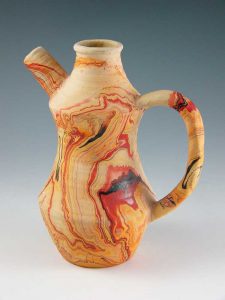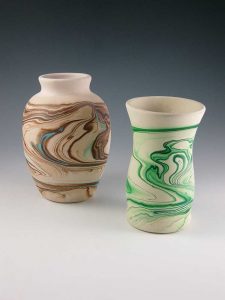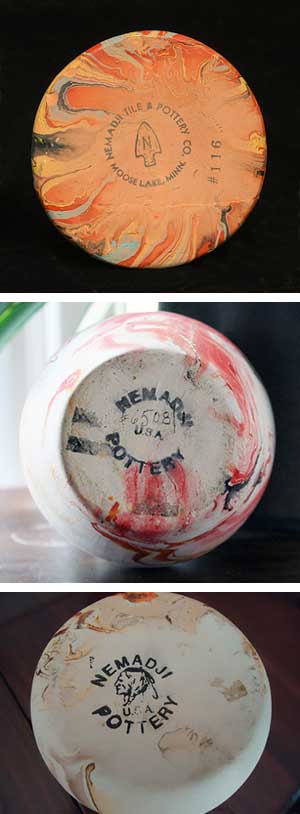Small Home Gazette, Winter 2019
Nemadji: Minnesota’s “Southwest” Pottery

A Nemadji pot in brown and green earth tones; 2½ inches high. From Nemadji’s early years.
What’s in a name? When it comes to Nemadji pottery, the answer is—plenty!
It’s 1940, and you’re a tourist out West. Maybe you’ve been visiting the Badlands and are now looking for the perfect souvenir. You spy an array of pottery bowls and vases in the Southwest style. The shapes are simple, accented by an eye-catching mix of multi-colored swirls against an earth tone base. You pick up a pot and flip it over. The stamp reads “Nemadji Indian Pottery—Native Clay USA.” How’s that for authenticity?
Well, while Nemadji is certainly in the Southwest style, northeastern Minnesota is where it actually hails from. But if the marking on that pot read “Made in Moose Lake,” would you have snapped it up? Probably not.

A Nemadji pitcher with orange and red swirls; 7½ inches high. Stamped “Contains Badlands Clay.” From Nemadji’s early years.
Nemadji occupies a unique place in the history of American pottery. From the company’s earliest days, its “up north” underpinnings were underplayed. A Nemadji catalog from the 1960s notes that the pottery was “…made largely from designs of ancient Indian pottery, and many of their traditional shapes are preserved in our designs.” As late as 1982, Better Homes & Gardens praised Nemadji’s “…rich earthen hues…made by the American Indians,” and many eBay listings still tout Nemadji as the perfect addition to a Native American collection.
So what exactly is Nemadji? The story begins with ceramist Frank Johnson. In 1920, Johnson founded the Northern Clay Products Company in Nemadji Township, just northeast of Moose Lake. The location, conveniently situated on a large bed of local Minnesota clay, was ideal for Johnson’s purposes. Specializing in industrial brick as well as some decorative hand-thrown pottery, Northern Clay was a success. But more capital was needed. For that, Johnson called on prominent Moose Lake attorney and lumberman, Clayton J. Dodge.

A pot with intricate swirls of orange, red and brown; 4 inches high. Stamped “Nemadji Blackhills Pottery.” Another example of Nemadji’s early years.
Dodge was happy to oblige. The newly-renamed Nemadji Tile and Pottery Company soon won nationwide acclaim for its decorative tile, used primarily for flooring. Hand-thrown Nemadji pottery was also popular, and there the difficulty set in. Dodge saw decorative pottery as a sure thing for the country’s burgeoning tourist trade. Johnson, however, had no interest in mass-produced ware, and the partnership ended.
Johnson’s replacement in 1929 proved largely responsible for the Nemadji designs today’s collectors covet. Danish immigrant Eric Hellman was happy to create the original thrown pottery needed to fashion molds for mass production. Hellman also modernized the Nemadji kilns; trained the company’s workers; and introduced the “cold striped” painting process, which gave Nemadji pottery its multi-colored swirls. (Essentially, cold striping involved dripping different colors of synthetic enamels into a tub of water. Each pottery piece was then dipped in the tub, until the colors adhered. A twist before removal resulted in the signature Nemadji swirls.)

Two Nemadji vases. Left: brown and aqua, 7¼ inches high. Right: light and dark greens, 6¼ inches high. From the final years of Nemadji (1995 – 2002).
Hellman remained at Nemadji only until 1931, leaving for Colorado and the establishment of his own studio. Hellman’s influence on the Nemadji output, however, was massive. Through changes of ownership and the addition of new product lines, right up until the company’s closing in 2002, Hellman’s original designs and techniques remained Nemadji’s bread and butter.
Now, for that Native American connection. Although the Moose Lake area was once home to the Ojibwe, by the time of the town’s founding in 1870, most original inhabitants had long since been moved to reservations. The most notable trace of their previous presence was the name “Nemadji.” This Ojibwe word, translated as “left hand,” was simply a directional term for the region’s first river on the left emptying into Lake Superior.

Nemadji’s wedding vase has two openings in honor of the bride and groom; red swirls, 10 inches high. From Nemadji’s “Earth Pottery Era” (1980 – 1995), an “Indian Head” image was included in the stamp.
Despite the legends and wishful thinking, there was no Nemadji tribe behind Nemadji pottery. Instead, in an era before cultural appropriation was recognized, enterprising ceramists created their own interpretations of Southwest style pottery. While definitely not what original buyers presumed it to be, Nemadji pottery has since found its own niche as a lovely; affordable (most pieces sell for well under $50); and sought-after example of mid-century Minnesota entrepreneurship.
Donald-Brian Johnson is the co-author of numerous books on design and collectibles, including Postwar Pop, a collection of his columns about pop culture collectibles from the 1920s to 1960s. Please address inquiries to: donaldbrian@msn.com.
The Nemadji pottery in the photos are courtesy of Maureen Maher. Photographer: Donald-Brian Johnson. Photo associate: Hank Kuhlmann.
A recommended book is: The Myth and Magic of Nemadji “Indian” Pottery: History, Identification, and Value Guide by Michelle Lee.
Nemadji Pottery Markings

Above are examples of the three types of stamps—an arrow for the early years; Nemadji name but no symbol (1930s to 1980); and the Indian head (used from 1980 onward).
Nemadji pottery was stamped on the bottom. Early pieces have arrowhead designs. From the 1930s to 1980, the word “Nemadji” was included in the stamp but without any symbol. And from 1980 onward, all stamps featured an Indian head. While there’s no question that the merchandising of Nemadji pottery exploited the American Indian, the pottery is still very collectible today.











